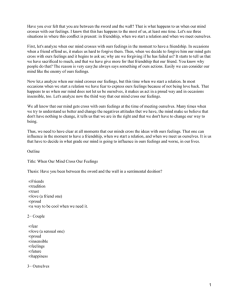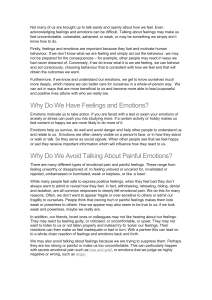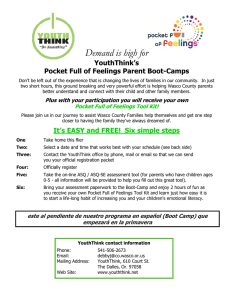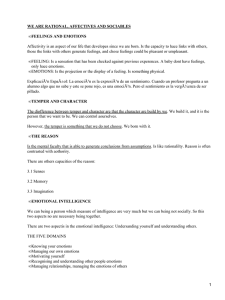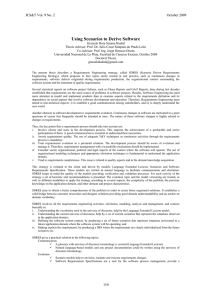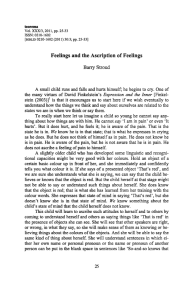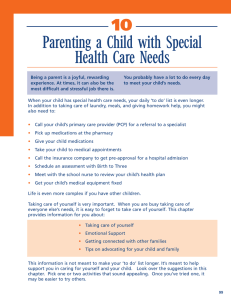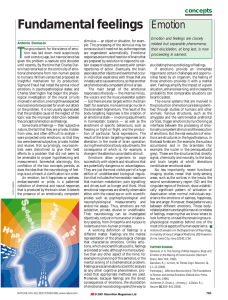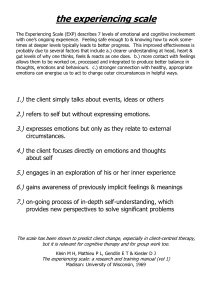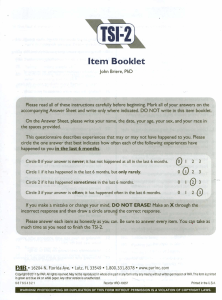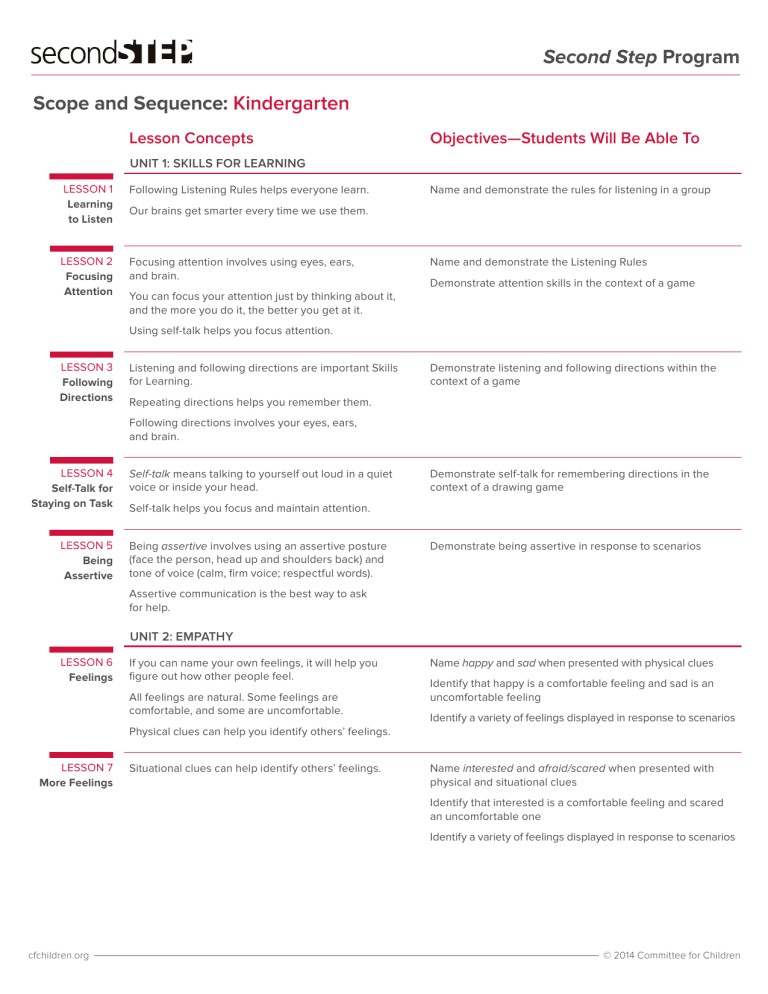
Second Step Program Scope and Sequence: Kindergarten Lesson Concepts Objectives­—Students Will Be Able To UNIT 1: SKILLS FOR LEARNING LESSON 1 Learning to Listen Following Listening Rules helps everyone learn. LESSON 2 Focusing Attention Focusing attention involves using eyes, ears, and brain. Name and demonstrate the rules for listening in a group Our brains get smarter every time we use them. Name and demonstrate the Listening Rules Demonstrate attention skills in the context of a game You can focus your attention just by thinking about it, and the more you do it, the better you get at it. Using self-talk helps you focus attention. LESSON 3 Following Directions Listening and following directions are important Skills for Learning. Demonstrate listening and following directions within the context of a game Repeating directions helps you remember them. Following directions involves your eyes, ears, and brain. LESSON 4 Self-Talk for Staying on Task LESSON 5 Being Assertive Self-talk means talking to yourself out loud in a quiet voice or inside your head. Demonstrate self-talk for remembering directions in the context of a drawing game Self-talk helps you focus and maintain attention. Being assertive involves using an assertive posture (face the person, head up and shoulders back) and tone of voice (calm, firm voice; respectful words). Demonstrate being assertive in response to scenarios Assertive communication is the best way to ask for help. UNIT 2: EMPATHY LESSON 6 Feelings If you can name your own feelings, it will help you figure out how other people feel. All feelings are natural. Some feelings are comfortable, and some are uncomfortable. Name happy and sad when presented with physical clues Identify that happy is a comfortable feeling and sad is an uncomfortable feeling Identify a variety of feelings displayed in response to scenarios Physical clues can help you identify others’ feelings. LESSON 7 More Feelings Situational clues can help identify others’ feelings. Name interested and afraid/scared when presented with physical and situational clues Identify that interested is a comfortable feeling and scared an uncomfortable one Identify a variety of feelings displayed in response to scenarios cfchildren.org © 2014 Committee for Children Second Step Program Scope and Sequence: Kindergarten Lesson Concepts Objectives­—Students Will Be Able To It is natural to feel angry, but feeling angry is uncomfortable. Name angry when presented with physical and situational clues It is not okay to be mean or hurt others. Identify that anger is an uncomfortable feeling Empathy means feeling and understanding what someone else feels. Identify a variety of feelings displayed in response to scenarios LESSON 9 Same or Different? People can have different feelings about the same situation. Compare physical and emotional similarities and differences between two students depicted in a story It is okay for people to have different feelings about the same thing. Identify same and different feelings in response to scenarios LESSON 10 Accidents An accident is when you do something you didn’t mean to do. Identify what to say when they do something by accident LESSON 8 Identifying Anger When you cause an accident, it’s important to say so, so others won’t think you did it on purpose. LESSON 11 Caring and Helping Compassion means caring about how someone else feels. When you feel empathy for someone, compassion is a good way to show it. Demonstrate saying, “I’m sorry. It was an accident. Are you okay?” in response to scenarios Identify that listening is one way to show you care Identify that helping is another way to show you care Demonstrate caring and helping behaviors in response to scenarios You can show you care by saying or doing something kind. UNIT 3: EMOTION MANAGEMENT LESSON 12 We Feel Feelings in Our Bodies You can use physical clues in your body to identify your feelings. LESSON 13 Managing Frustration Feelings vary in strength. LESSON 14 Calming Down Strong Feelings LESSON 15 Handling Waiting cfchildren.org Identify physical clues for feeling worried Identify a grown-up to talk to when they feel worried All your feelings are natural. It is important to talk to a grown-up when you feel worried. Feelings that are strong need to be managed. Saying “Stop” and naming your feelings are ways to begin to calm down. Identify “Stop” and “Name your feeling” as ways to begin to calm down Demonstrate saying “Stop” and naming feelings in response to scenarios Belly breathing calms down strong feelings. Demonstrate belly breathing Belly breathing pushes the belly out when you breathe in. Identify and demonstrate the Calming-Down Steps The Calming-Down Steps can help you manage feeling excited or impatient while waiting. Identify the Calming-Down Steps Finding quiet things to do that won’t distract others also helps you wait. Apply the Calming-Down Steps while waiting in a game situation © 2014 Committee for Children Second Step Program Scope and Sequence: Kindergarten LESSON 16 Managing Anger Lesson Concepts Objectives­—Students Will Be Able To Feeling angry is natural. Hurtful, mean behaviors are not okay. Name physical signs of anger Apply the Calming-Down Steps in a game situation Your body lets you know when you are angry. Learning to relax calms you down. LESSON 17 Managing Disappointment When you don’t get what you want, you can feel disappointed. LESSON 18 Handling Being Knocked Down When you get hurt, it’s important to calm down before you do anything else. Identify the feeling of disappointment Demonstrate calming-down skills when they feel disappointed Strong disappointment can lead to feeling sad or angry. You need to ask for more information and not assume that the action was on purpose. Demonstrate calming down in response to scenarios Demonstrate telling the other person they feel hurt and asking what happened Demonstrate apologizing and saying it was an accident UNIT 4: PROBLEM SOLVING LESSON 19 Solving Problems You need to calm down before you solve a problem. Use words to describe problems presented in scenarios The first step in solving problems is to use words to describe the problem. Generate multiple solutions to problems presented in scenarios The second step in solving problems is to think of lots of solutions. LESSON 20 Inviting to Play When you see other kids being left out of play, it is important to notice and have empathy for them. Demonstrate inviting someone to play in response to scenarios Inviting others to play is a caring thing to do. Playing with others is a way to get to know them. LESSON 21 Fair Ways to Play LESSON 22 Having Fun with Our Friends Sharing, trading, and taking turns are fair ways to play. Identify a problem in response to a scenario Sharing means playing together with a toy. Generate solutions in response to a scenario Name sharing, trading, and taking turns as fair solutions when two students want to play with the same thing When children play in fair ways, everyone has fun. Other children sometimes have different wants or preferences. Demonstrate the Problem-Solving Steps with a problem in the lesson Choosing to have fun with others rather than get your own way helps you be friends. cfchildren.org © 2014 Committee for Children Second Step Program Scope and Sequence: Kindergarten LESSON 23 Handling Having Things Taken Away Lesson Concepts Objectives­—Students Will Be Able To It is important to calm down first before solving problems. Identify a problem in response to scenarios If someone is being mean to you on purpose, using words and being assertive are good ways to deal with it. Generate solutions in response to scenarios Demonstrate assertive communication in response to scenarios It is not okay to grab things away from others. LESSON 24 Handling Name-Calling It is not okay to call people names that hurt their feelings. Demonstrate assertiveness and ignoring as effective strategies for handling name calling that hurts feelings If someone calls you a name, you can ignore the person or respond assertively. Identify an adult to tell if they cannot stop the name-calling If the person doesn’t stop calling you names, you should tell a grown-up. LESSON 25 Reviewing Second Step Skills cfchildren.org You have all learned a lot of new skills. You can notice how much you have learned. Recall and demonstrate the Listening Rules Demonstrate how to calm down Recall the Fair Ways to Play © 2014 Committee for Children Second Step Program Scope and Sequence: Grade 1 Lesson Concepts Objectives­—Students Will Be Able To UNIT 1: SKILLS FOR LEARNING LESSON 1 Learning to Listen Following Listening Rules helps everyone learn. Name and demonstrate the Listening Rules Your brain gets smarter every time it works hard. Apply attention, memory, and inhibitory control skills in a brain-building game LESSON 2 Focusing Attention Focusing attention involves using your eyes, ears, and brain. Name and demonstrate the Listening Rules The more you practice focusing your attention, the better you get at it. Demonstrate attention skills in the context of a game State typical classroom verbal cues that request student attention Using self-talk helps focus attention. LESSON 3 Following Directions Listening and following directions are important Skills for Learning. Demonstrate listening and following directions within the context of a game Repeating directions helps you remember them. Following directions involves using your eyes, ears, and brain. LESSON 4 Self-Talk for Learning LESSON 5 Being Assertive Self-talk means talking to yourself out loud in a quiet voice or inside your head. Demonstrate self-talk strategies for remembering directions Self-talk helps you focus and maintain attention. Being assertive involves using an assertive posture (face the person, head up and shoulders back) and tone of voice (calm, firm voice; respectful words). Assertive communication is the best way to ask for help. Distinguish an assertive request from a passive or aggressive one Identify assertive posture and tone of voice Demonstrate assertive communication skills in response to scenarios UNIT 2: EMPATHY LESSON 6 Identifying Feelings Identifying your own feelings helps you know how others feel. Name feelings when presented with physical clues Everyone experiences strong feelings sometimes. Some feelings are comfortable, and some are uncomfortable. Physical clues can help identify others’ feelings. LESSON 7 Looking for More Clues LESSON 8 Similarities and Differences cfchildren.org Situational clues can help you identify others’ feelings. Name feelings when presented with physical clues Understanding how others feel improves relationships. Name feelings when presented with environmental and situational clues People can have different feelings about the same situation. Compare physical and emotional similarities and differences between two children It is okay for people to have different feelings about the same thing. Demonstrate that people can have different feelings about the same situation © 2014 Committee for Children Second Step Program Scope and Sequence: Grade 1 LESSON 9 Feelings Change Lesson Concepts Objectives­—Students Will Be Able To People may have different feelings about the same situation at different times. Demonstrate welcoming and inviting behaviors Feelings may change over time. Being inviting and welcoming can change people’s feelings. LESSON 10 Accidents An accident is when you do something you didn’t mean to do. It is important to accept responsibility for an accident to prevent others from assuming it was intentional. LESSON 11 Showing Care and Concern Compassion is empathy in action. People feel better when others show them care and concern. Know what the word accident means Know what to say when they do something by accident Predict how others might feel as a result of their own or others’ actions Recall that listening, saying kind words, and helping are three ways to show caring Demonstrate caring and helping in response to scenarios UNIT 3: EMOTION MANAGEMENT LESSON 12 Identifying Our Own Feelings You identify your own feelings by physical clues in your body. Identify physical clues in their bodies that help them identify their feelings All feelings are natural. Identify grown-ups to talk to about feelings LESSON 13 Strong Feelings Feelings vary in strength. Recognize situations and physical body cues that signal strong feelings Strong feelings need to be managed. Saying “Stop” and naming your feeling are ways to begin to calm down. LESSON 14 Calming Down Anger Belly breathing calms down strong feelings. Explain physical and situational clues to feeling angry Belly breathing pushes the belly out when you breathe in. Demonstrate the proper belly breathing technique Being mean or hurting others when you are angry is not okay. LESSON 15 Self-Talk for Calming Down LESSON 16 Managing Worry cfchildren.org Demonstrate two Calming-Down Steps to manage strong feelings Positive self-talk is an effective strategy for calming down strong emotions. Use a three-step process to calm down: Say “stop,” name your feeling, and do belly breathing Recognize situations that require the use of calming-down strategies Use positive self-talk to calm down Counting is an effective Way to Calm Down. Recognize situations that require the use of calming-down skills The Ways to Calm Down can help students manage worry. Demonstrate the Ways to Calm Down—belly breathing, counting, and using positive self-talk Talking to a grown-up helps when you are worried. Identify grown-ups to talk to when feeling worried © 2014 Committee for Children Second Step Program Scope and Sequence: Grade 1 Lesson Concepts Objectives­—Students Will Be Able To UNIT 4: PROBLEM SOLVING LESSON 17 Solving Problems, Part 1 You need to calm down before you solve a problem. Use words to describe problems presented in scenarios The first step in solving a problem is to use words to describe the problem. Generate multiple solutions to problems presented in scenarios The second step in solving a problem is to think of lots of solutions. LESSON 18 Solving Problems, Part 2 Part of problem solving is thinking about consequences. Predict consequences using an if-then model The final step of problem solving is to pick the best solution. Select a reasonable solution to a problem Solving problems is a way to get along better with others. LESSON 19 Fair Ways to Play Sharing, trading, and taking turns are fair ways to play. Define and differentiate sharing, trading, and taking turns Sharing means playing together with a toy. Identify and state the problem in a given situation Generate possible solutions to a problem situation Demonstrate the Fair Ways to Play LESSON 20 Inviting to Join In It is important to notice and have empathy for children who are left out of play. Inviting others to play is the right thing to do. Apply the Problem-Solving Steps Demonstrate how to invite someone to play in response to scenarios Playing with others is a way to get to know them better. LESSON 21 Handling Name-Calling It is not okay to call people names that hurt their feelings. Demonstrate assertive responses to name-calling Identify adults to tell if name-calling doesn’t stop If someone calls you a name, you can ignore the person or speak assertively. If the person doesn’t stop calling you names, you should tell a grown-up. LESSON 22 Reviewing Second Step Skills You have all learned a lot of new skills. Recall skills on all the posters You can notice how much you have learned. Demonstrate the Listening Rules Demonstrate the Calming-Down Steps Name one concept or skill they learned in their Second Step lessons cfchildren.org © 2014 Committee for Children Second Step Program Scope and Sequence: Grade 2 Lesson Concepts Objectives­—Students Will Be Able To UNIT 1: SKILLS FOR LEARNING LESSON 1 Being Respectful LESSON 2 Focusing Attention and Listening Thinking about how others want to be treated and treating them that way helps you be respectful. Identify respectful behavior in themselves and others Determine respectful responses to scenarios Being respectful helps you be a better learner. Focusing your attention and listening help you be a better learner. Focusing your attention and listening are ways to show respect. Identify examples of focusing attention Identify examples of listening Apply focusing-attention and listening skills in the context of a game and in response to scenarios LESSON 3 Using Self-Talk Self-talk means talking to yourself in a quiet voice or in your head. LESSON 4 Being Assertive Being assertive means asking for what you want or need in a calm and firm voice. Demonstrate assertive communication skills in response to scenarios Being assertive is a respectful way to get what you want or need. Determine which adult to ask assertively for help in response to scenarios Identify classroom distractions Demonstrate using self-talk in response to scenarios Self-talk helps you focus, stay on task, and handle distractions. UNIT 2: EMPATHY LESSON 5 Identifying Feelings Clues in faces, bodies, and situations help you notice and understand how people are feeling. Everyone feels a wide variety of emotions. Some feelings are comfortable, and others are uncomfortable. LESSON 6 Learning More About Feelings LESSON 7 Feeling Confident Name a variety of feelings Distinguish between comfortable and uncomfortable feelings Use physical, verbal, and situational clues to determine what others are feeling People can have different feelings about the same situation. Use physical, verbal, and situational clues to determine what others are feeling People’s feelings can change. Label their own feelings as the same as or different from others’ feelings Empathy is feeling or understanding what someone else is feeling. Practicing helps you build your confidence. Feeling confident helps you do your best and makes you proud. Identify physical and situational clues that indicate the feeling of confidence Detect when their own and others’ feelings change Noticing how others feel and understanding that their feelings can change helps you have empathy. LESSON 8 Respecting Different Preferences cfchildren.org Having empathy helps you notice when others have different preferences from yours. Determine what others are feeling using physical, verbal, and situational clues Respecting others’ preferences helps you get along better with them. Label their own preferences as the same as or different from others’ preferences © 2014 Committee for Children Second Step Program Scope and Sequence: Grade 2 LESSON 9 Showing Compassion Lesson Concepts Objectives­—Students Will Be Able To Noticing and understanding what someone is feeling helps you have empathy. Determine what others are feeling using physical, verbal, and situational clues When you have empathy for someone, you can show your care and concern by saying something kind or doing something to help. Identify ways to show compassion for others in response to scenarios Showing care and concern is called showing compassion. LESSON 10 Predicting Feelings Accidents happen. Predict others’ feelings in response to scenarios If something happens to you by accident, think about how it could have been an accident and find out more information. Offer possible reasons for others’ actions and feelings in response to scenarios If you do something by accident, think about how the other person feels, apologize, and offer to help. UNIT 3: EMOTION MANAGEMENT LESSON 11 Introducing Emotion Management LESSON 12 Managing Embarrassment LESSON 13 Handling Making Mistakes When you feel strong feelings, it’s hard to think clearly. Focusing attention on your body gives you clues about how you’re feeling. Identify physical clues that can help them name their own feelings Thinking about your feelings helps the thinking part of your brain get back in control. Using a stop signal and naming your feeling are the first two Calming-Down Steps. Identify the first two Calming-Down Steps Everyone makes mistakes, but if you’re feeling strong feelings, it’s important to calm down. Demonstrate correct belly-breathing technique Demonstrate first two Calming-Down Steps in response to scenarios Use belly breathing to calm down in response to scenarios Making mistakes helps you learn, because mistakes show you what you need to practice more. You can use belly breathing to calm down. LESSON 14 Managing Anxious Feelings Negative self-talk can make strong feelings even stronger. Generate positive self-talk they can use to calm down in response to scenarios When you feel really worried and anxious about something, calming down helps. Use positive self-talk to calm down in response to scenarios Using positive self-talk can help you calm down. LESSON 15 Managing Anger Everyone feels angry sometimes, but hurting other people’s feelings or bodies is not okay. It’s important to calm down angry feelings so you don’t do something hurtful. Use counting to calm down in response to scenarios Use assertive communication skills to get what they want or need in response to scenarios Being assertive is a respectful way to get what you want or need. cfchildren.org © 2014 Committee for Children Second Step Program Scope and Sequence: Grade 2 LESSON 16 Finishing Tasks Lesson Concepts Objectives­—Students Will Be Able To Calming down helps you stay focused and on task at school. Identify situations that require the use of the Calming-Down Steps Using positive self-talk helps you stay focused and on task so you can be a better learner. Demonstrate using the Calming-Down Steps in response to scenarios Use positive self-talk to stay focused and on task in response to scenarios UNIT 4: PROBLEM SOLVING LESSON 17 Solving Problems, Part 1 Calming down helps you think so you can solve problems. Recall the first Problem-Solving Step Identify and say a problem in response to scenarios Following steps can help you solve problems. Saying the problem without blame is respectful. LESSON 18 Solving Problems, Part 2 Following steps can help you solve problems. Recall the first two Problem-Solving Steps Solutions to problems must be safe and respectful. Generate several solutions for a given problem in response to scenarios Determine if solutions are safe and respectful LESSON 19 Taking Responsibility LESSON 20 Responding to Playground Exclusion LESSON 21 Playing Fairly on the Playground Following steps can help you solve problems. Recall the Problem-Solving Steps When you hurt someone’s feelings, it’s important to take responsibility. Apply the Problem-Solving Steps to scenarios about conflicts with friends Taking responsibility means admitting what you did, apologizing, and offering to make amends. Demonstrate accepting responsibility for their actions by admitting, apologizing, and offering to make amends in response to scenarios Following steps can help you solve problems. Recall the Problem-Solving Steps Being left out is a problem. Apply the Problem-Solving Steps to scenarios that involve playground problems, such as students being left out intentionally Inviting someone who is being left out to play is the respectful, compassionate thing to do. Calming down helps you think so you can solve problems. Following steps can help you solve problems. Recall the Problem-Solving Steps Apply the Problem-Solving Steps to scenarios that involve playground conflicts that arise during games When you can’t agree on rules for a game, it’s a problem. Finding a respectful way to agree on rules helps you get along better with others. LESSON 22 Reviewing Second Step Skills cfchildren.org Using Second Step skills can help you be a better learner and get along with others. Recall Second Step skills learned Identify Second Step skills in a story Relate personal examples of skill use © 2014 Committee for Children Second Step Program Scope and Sequence: Grade 3 Lesson Concepts Objectives­—Students Will Be Able To UNIT 1: SKILLS FOR LEARNING LESSON 1 Being Respectful Learners LESSON 2 Using Self-Talk Focusing your attention and listening help you be a better learner. Apply focusing-attention and listening skills in response to scenarios. Focusing your attention and listening show respect. Self-talk means talking to yourself in a quiet voice or in your head. Identify classroom distractions Demonstrate the use of self-talk in response to scenarios Self-talk can help you focus, stay on task, and handle distractions. LESSON 3 Being Assertive Being assertive means asking for what you want or need in a calm and firm voice. LESSON 4 Planning to Learn Making a plan can help you be a better learner. Demonstrate assertive communication skills in response to scenarios Being assertive is a respectful way to get what you want or need. A plan is good if the order makes sense, it’s simple, and you can do it. Evaluate three-step plans for different scenarios using the Good Plan Checklist criteria Create a simple, three-step plan that meets the Good Plan Checklist criteria UNIT 2: EMPATHY LESSON 5 Identifying Others’ Feelings Looking for clues on a person’s face or body and in the situation helps you notice and understand how that person is feeling. People can have different feelings about the same situation. Name a variety of feelings Determine others’ feelings using physical, verbal, and situational clues Label their own feelings as the same as or different from others’ feelings All feelings are natural. LESSON 6 Understanding Perspectives People can have different feelings about the same situation, and their feelings can change. Identify others’ feelings using physical, verbal, and situational clues Empathy is feeling or understanding what someone else is feeling. Determine whether others’ feelings have changed, in response to scenarios Thinking about others’ perspectives helps you have empathy for them. LESSON 7 Conflicting Feelings You can have conflicting feelings about a situation. LESSON 8 Accepting Differences Having empathy helps you understand and accept how others are the same as or different from you. cfchildren.org Having empathy helps you notice when others’ feelings are the same as or different from yours. Identify two conflicting feelings a person could have in response to scenarios Explain possible reasons for someone’s conflicting feelings in response to scenarios Name similarities and differences between people Predict how others will feel when teased for being different Accepting and appreciating others’ differences is respectful. © 2014 Committee for Children Second Step Program Scope and Sequence: Grade 3 LESSON 9 Showing Compassion Lesson Concepts Objectives­—Students Will Be Able To Focusing attention on and listening to others can help you have empathy and show compassion. Demonstrate focusing-attention and listening skills in response to scenarios You can say kind words or do helpful things to show your compassion. Identify ways to show compassion for others in response to scenarios Express appreciation for another person’s concern in response to scenarios LESSON 10 Making Friends Focusing attention and listening to others help you make conversation. Demonstrate focusing-attention and listening skills in the context of a game Making conversation helps you make friends and get along better with others. Initiate, continue, and end a conversation in a friendly way in the context of a game UNIT 3: EMOTION MANAGEMENT LESSON 11 Introducing Emotion Management When you feel strong feelings, it’s hard to think clearly. Focusing attention on your body gives you clues about how you’re feeling. Identify physical clues that can help them label their own feelings Thinking about your feelings helps the thinking part of your brain get back in control. LESSON 12 Managing Test Anxiety Using a stop signal and naming your feeling are the first two Calming-Down Steps. Identify the first two Calming-Down Steps LESSON 13 Handling Accusations You can use belly breathing to calm down. Demonstrate correct belly-breathing technique Calming down helps you handle accusations calmly and thoughtfully. Use belly breathing to calm down in response to scenarios It’s important to take responsibility when you’ve made a mistake. LESSON 14 Managing Disappointment Demonstrate steps for handling accusations in response to scenarios Negative self-talk can make strong feelings even stronger. Generate positive self-talk they can use to calm down in response to scenarios You can calm down by using positive self-talk. Make a simple three-step plan to achieve a goal in response to scenarios Setting a new goal and making a plan to achieve it are positive ways to handle disappointment. LESSON 15 Managing Anger Demonstrate using the first two Calming-Down Steps in response to scenarios Everyone feels angry sometimes, but hurting other people’s feelings or bodies is not okay. It’s important to calm down angry feelings so you don’t do something hurtful. Use counting to calm down in response to scenarios Use assertive communication skills to get what they want or need in response to scenarios Being assertive is a respectful way to get what you want or need. cfchildren.org © 2014 Committee for Children Second Step Program Scope and Sequence: Grade 3 LESSON 16 Managing Hurt Feelings Lesson Concepts Objectives­—Students Will Be Able To Calming down when your feelings have been hurt can help you avoid jumping to conclusions. Identify situations that require using strategies for calming down Thinking of other explanations and getting more information can help you avoid jumping to conclusions. Demonstrate using strategies for calming down Generate alternative explanations in response to scenarios UNIT 4: PROBLEM SOLVING LESSON 17 Solving Problems, Part 1 Calming down helps you think so you can solve problems. Following steps can help you solve problems. Recall the first Problem-Solving Step Identify and state a problem in response to scenarios Identify blaming language in response to scenarios Saying the problem without blame is respectful. LESSON 18 Solving Problems, Part 2 Following steps can help you solve problems. Recall the Problem-Solving Steps Solutions to problems must be safe and respectful. Propose several solutions for a given problem in response to scenarios Solutions can have positive or negative consequences. Determine if solutions are safe and respectful Explore positive and negative consequences of solutions LESSON 19 Solving Classroom Problems Calming down helps you think so you can solve problems. Apply the Calming-Down Steps to an emotional situation in response to a scenario Following steps can help you solve problems. Recall the Problem-Solving Steps Getting along with others helps you be a better learner at school. Use the Problem-Solving Steps to solve an interpersonal problem between classmates, in response to a scenario LESSON 20 Solving Peer-Exclusion Problems Following steps can help you solve problems. Apply the Problem-Solving Steps to the problem of being excluded by peers, in response to scenarios LESSON 21 Dealing with Negative Peer Pressure Calming down helps you think so you can solve problems. Apply the Problem-Solving Steps to the problem of being negatively pressured by peers, in response to scenarios Following steps can help you solve problems. Demonstrate assertive communication in response to scenarios LESSON 22 Reviewing Second Step Skills cfchildren.org Being assertive is a safe and respectful solution to problems like being excluded. Excluding others is not nice or respectful. Demonstrate assertive communication skills in response to scenarios Being assertive can help you resist negative peer pressure. Using Second Step skills can help you be a better learner and get along with others. Recall Second Step skills learned Identify Second Step skills in a story Relate personal examples of skill use © 2014 Committee for Children Second Step Program Scope and Sequence: Grade 4 Lesson Concepts Objectives­—Students Will Be Able To UNIT 1: EMPATHY AND SKILLS FOR LEARNING LESSON 1 Empathy and Respect LESSON 2 Listening with Attention LESSON 3 Being Assertive The Second Step program helps you succeed at school. Define respect Having respect and empathy helps you get along with others. Define empathy Listening with attention helps you learn, work with others, and make friends. Demonstrate listening-with-attention skills Being assertive means asking for what you want or need in a calm, firm, respectful voice. Identify passive, aggressive, and assertive responses LESSON 4 Respecting Similarities and Differences People can have similar or different feelings about the same situation. LESSON 5 Understanding Complex Feelings It is possible to have more than one feeling at the same time. LESSON 6 Understanding Different Perspectives People can have different perspectives about other people, places, and situations. LESSON 7 Conversation and Compliments LESSON 8 Joining In LESSON 9 Showing Compassion Demonstrate assertive responses with their partners Being assertive helps you be successful in a variety of social and academic situations. Being able to notice and then understand others’ feelings is an important part of empathy. Identify clues that help them recognize other people’s feelings Identify similarities and differences between how two people feel Identify multiple feelings in a given scenario Give possible reasons for multiple feelings Being able to understand that others might have complex feelings is an important part of empathy. Perspective taking is a central component of empathy. Having successful conversations with peers helps you make and build friendships. Identify differing perspectives in given scenarios Generate prosocial responses to scenarios in which different perspectives could cause a conflict Identify components of a successful conversation Demonstrate giving and receiving a compliment Giving a sincere, thoughtful compliment is a good way to start a conversation or keep one going. Being assertive can help you join and invite others to join a group. Identify skills for joining a group Compassion means saying kind words or doing something helpful to show you care about how another person feels. Demonstrate expressing concern or showing compassion for someone Demonstrate skills for joining a group Having empathy helps you show compassion. cfchildren.org © 2014 Committee for Children Second Step Program Scope and Sequence: Grade 4 Lesson Concepts Objectives­—Students Will Be Able To UNIT 2: EMOTION MANAGEMENT LESSON 10 Introducing Emotion Management LESSON 11 Managing Strong Feelings When you feel strong feelings, it’s hard to think clearly. Describe what triggers their own strong emotions Unmanaged, strong emotions can lead to negative behavior and consequences. Describe what happens in their brains and bodies when they experience strong emotions Staying in control of your emotions and actions helps you get along better with others and be successful at school. Demonstrate the ability to interrupt escalating emotions Determine a personal “signal” Identify and name strong feelings as they occur LESSON 12 Calming Down Anger Calming down emotions that are getting out of control helps you think clearly so you can avoid negative consequences. Identify situations in which they might need to calm down Demonstrate the technique for deep, centered breathing Identify and demonstrate other Ways to Calm Down (counting, using positive self-talk) LESSON 13 Managing Anxiety Effectively managing your anxiety makes it easier to focus and succeed in social and academic situations. Identify situations that cause anxiety LESSON 14 Avoiding Jumping to Conclusions Calming down strong emotions helps you think clearly about a situation so you can avoid jumping to conclusions. Identify emotion-management strategies LESSON 15 Handling Put-Downs Calming down helps you handle put-downs and avoid making conflicts escalate. Apply what they’ve learned about calming down to anxietyprovoking scenarios, including academic challenges Demonstrate assertiveness skills Identify and demonstrate positive self-talk statements Identify strategies for handling put-downs Demonstrate what they’ve learned about strategies for calming down Demonstrate assertive responses to put-downs cfchildren.org © 2014 Committee for Children Second Step Program Scope and Sequence: Grade 4 Lesson Concepts Objectives­—Students Will Be Able To UNIT 3: PROBLEM SOLVING LESSON 16 Solving Problems, Part 1 Following steps can help you solve problems. Saying the problem without blame is respectful. Solving problems helps you be successful at school. LESSON 17 Solving Problems, Part 2 Solving problems helps you be successful at school. Recall the S: Say the problem step of the Problem-Solving Steps State a problem without blaming anyone Generate safe and respectful solutions to a problem Identify consequences of potential solutions Select an appropriate solution to a problem LESSON 18 Making a Plan Some solutions to problems are complicated and need a plan. Explain the purpose of making a plan Create a three-step plan to carry out a solution to a problem Plans help you break down a big task into smaller, more manageable parts. LESSON 19 Solving Playground Problems LESSON 20 Taking Responsibility for Your Actions You are better able to resolve playground conflicts when you are able to calm down and use the ProblemSolving Steps. Identify common playground conflicts Taking responsibility for your actions is the respectful thing to do. Demonstrate the ability to use the Problem-Solving Steps to handle scenarios in which someone has been wronged Demonstrate using the Problem-Solving Steps to handle playground conflicts Demonstrate acknowledging mistakes Demonstrate making an apology and offering to make amends LESSON 21 Dealing with Peer Pressure LESSON 22 Reviewing Second Step Skills cfchildren.org It is okay to say no to others, and it is okay for them to say no to you. Negative emotions like guilt and remorse can be reasons not to go along with peer pressure. The skills and concepts learned in the Second Step program can help you succeed in school. Demonstrate using assertiveness skills to resist peer pressure Demonstrate using the Problem-Solving Steps to figure out ways to resist peer pressure Identify Second Step skills and concepts being used in scenarios students might encounter at school Include Second Step skills in a written script about solving a problem © 2014 Committee for Children Second Step Program Scope and Sequence: Grade 5 Lesson Concepts Objectives­—Students Will Be Able To UNIT 1: EMPATHY AND SKILLS FOR LEARNING LESSON 1 Empathy and Respect LESSON 2 Listening with Attention LESSON 3 Being Assertive The Second Step program helps you succeed at school. Define respect Define empathy Having respect and empathy helps you get along with others. Listening with attention helps you learn, work with others, and make friends. Demonstrate listening-with-attention skills Being assertive means asking for what you want or need in a calm, firm, respectful voice. Identify passive, aggressive, and assertive responses Demonstrate assertive responses with their partners Being assertive helps you be successful in a variety of social and academic situations. LESSON 4 Predicting Feelings LESSON 5 Taking Others’ Perspectives LESSON 6 Accepting Differences LESSON 7 Disagreeing Respectfully LESSON 8 Responding with Compassion Being able to predict how what you do or say might make other people feel is respectful and will help you get along better with others. Predict how others might feel as a result of their or another’s actions Others may have different perspectives. Demonstrate the ability to take someone else’s perspective State the cause and effects of a given action Being able to recognize someone else’s perspective helps you get along with others. Accepting differences and finding similarities can create mutual respect and friendship. Identify similarities and differences between two people Disagreeing respectfully involves using assertiveness skills. Distinguish between respectful and disrespectful ways to disagree Disagreeing respectfully helps you strengthen your relationships, avoid misunderstandings, and prevent aggressive conflicts. Communicate their own perspectives Compassion is saying kind words or doing something to show you care about how another person feels. Demonstrate knowledge of how to respond with compassion Define prejudice Demonstrate skills for disagreeing respectfully Showing compassion for others is the respectful, kind thing to do. Having empathy helps you show compassion cfchildren.org © 2014 Committee for Children Second Step Program Scope and Sequence: Grade 5 Lesson Concepts Objectives­—Students Will Be Able To UNIT 2: EMOTION MANAGEMENT LESSON 9 Introducing Emotion Management LESSON 10 Calming Down When you have strong, unmanaged emotions, it can lead to negative behavior and consequences. Describe what happens in their brains and bodies when they experience strong emotions Identify a personal signal Identify and name strong feelings Calming down emotions that are getting out of control helps you think clearly so you can avoid negative consequences. Identify situations in which they might need to calm down Learn the technique for deep, centered breathing Identify and demonstrate other Calming Down Strategies (using positive self-talk, counting, taking a break) LESSON 11 Managing Anxiety LESSON 12 Managing Frustration LESSON 13 Resisting Revenge Managing your anxiety effectively makes it easier to focus and succeed in social and academic situations. Identify social situations that can cause anxiety Frustration can get in the way of learning. Identify physical signs of frustration Managing frustration reduces the chance of doing something you may regret later. Demonstrate reducing frustration by using the Calming-Down Steps Getting revenge can make problems worse. Identify consequences of revenge Apply what they’ve learned about calming down in scenarios causing social anxiety Generate alternatives for seeking revenge Demonstrate using the Calming-Down Steps LESSON 14 Handling Put-Downs Calming down helps you handle put-downs and avoid escalating conflicts. Identify strategies for handling put-downs Demonstrate what they’ve learned about the Calming-Down Steps Demonstrate assertive responses to put-downs LESSON 15 Avoiding Assumptions Calming down strong emotions helps you think clearly about a situation and make better decisions. Identify emotion-management strategies Demonstrate assertiveness skills Identify and use positive self-talk statements to avoid making assumptions cfchildren.org © 2014 Committee for Children Second Step Program Scope and Sequence: Grade 5 Lesson Concepts Objectives­—Students Will Be Able To UNIT 3: PROBLEM SOLVING LESSON 16 Solving Problems, Part 1 LESSON 17 Solving Problems, Part 2 Solving problems helps you be successful at school. Recall the S: Say the problem step of the Problem-Solving Steps State a problem without blaming anyone Solving problems helps you be successful at school. Generate safe and respectful solutions to a problem Identify consequences of potential solutions Select an appropriate solution to a problem LESSON 18 Making a Plan Some solutions to problems are complicated and need a plan. Explain the purpose of making a plan Create a three-step plan to carry out a solution to a problem Plans help you break down a big task into smaller, more manageable parts. LESSON 19 Seeking Help LESSON 20 Dealing with Gossip Seeking help from a trusted adult is sometimes the best solution. State the Problem-Solving Steps Malicious gossip is hurtful and not respectful to others. Identify why some gossip is harmful Demonstrate using assertiveness skills when seeking help Generate ideas for refusing or avoiding harmful gossip Demonstrate using the Problem-Solving Steps to deal with gossip LESSON 21 Dealing with Peer Pressure LESSON 22 Reviewing Second Step Skills cfchildren.org It is okay to say no to others, and it is okay for them to say no to you. Negative emotions like guilt and remorse can be reasons not to go along with peer pressure. The skills and concepts learned in the Second Step program can help you succeed in school. Demonstrate using assertiveness skills to resist peer pressure Demonstrate using the Problem-Solving Steps to figure out ways to resist peer pressure Identify Second Step skills and concepts being used in scenarios students might encounter at school Include Second Step skills in a written script about solving a problem © 2014 Committee for Children
